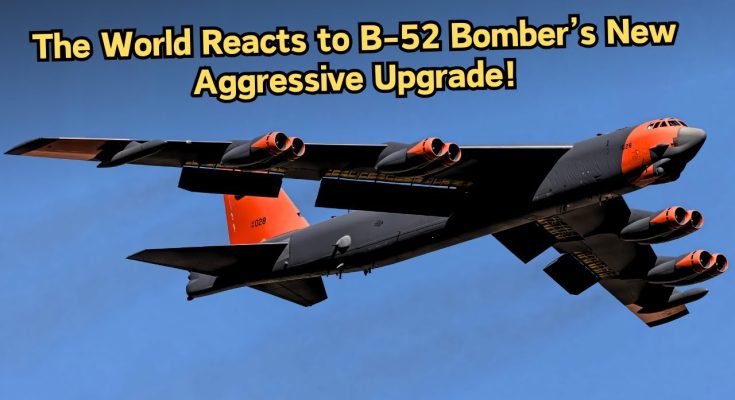In 2025, the United States took a bold step in modernizing its long-range strike capabilities by unveiling an aggressive upgrade of its iconic B-52 Stratofortress bomber, which has been a cornerstone of the U.S. Air Force’s strategic bombing fleet for over 60 years. The revamped B-52, often referred to as the B-52J or B-52X in various sources, has stunned the world with its combination of cutting-edge technology, increased firepower, and enhanced survivability. This upgrade has solidified the B-52’s position as one of the most formidable assets in America’s air power, extending its service life well into the 2050s and beyond.
Modernization of the Airframe and Avionics
The B-52, originally designed in the 1950s, was never meant to endure this long in service. However, the latest upgrades breathe new life into the aircraft, ensuring it remains a crucial part of the U.S. strategic arsenal. One of the most notable updates is the complete overhaul of the airframe. Aging components have been replaced with modern, lightweight materials, significantly reducing the aircraft’s weight and enhancing its fuel efficiency. This has not only extended the bomber’s lifespan but also improved its ability to carry out long-range missions without needing frequent refueling.
On the inside, the B-52’s cockpit has been completely revamped with state-of-the-art avionics, bringing it into the 21st century. Gone are the outdated mechanical systems; in their place are digital flight controls, enhanced navigation systems, and new radar technology that provides a clearer, more comprehensive view of the battlefield. The cockpit also features digital displays that allow pilots to control a wide array of weapons and systems with ease, making it more efficient and user-friendly.
Powerful New Weapons Systems
Perhaps the most stunning feature of the B-52’s aggressive upgrade is its expanded weapons capability. Historically, the B-52 was a platform designed for carrying a variety of nuclear and conventional bombs. The upgraded B-52, however, is now able to carry a much broader range of advanced munitions, including hypersonic weapons, precision-guided bombs, and air-launched cruise missiles. These weapons systems are designed to target high-value assets with incredible precision, even in heavily defended airspaces.
The B-52 can now launch hypersonic missiles, which travel at speeds greater than Mach 5, making them nearly impossible to intercept with current missile defense systems. This greatly enhances the bomber’s ability to strike high-value targets in heavily defended environments without fear of retaliation.
Additionally, the aircraft has been equipped with next-generation electronic warfare systems that allow it to disrupt enemy radar and missile systems. This offensive and defensive capability ensures the B-52 can operate even in the most challenging contested environments, where air defenses might have previously been a significant threat.
Improved Survivability and Defense Systems
In modern warfare, survivability is key, and the B-52’s latest upgrades ensure it can withstand modern threats. The aircraft has been fitted with advanced stealth technology, reducing its radar cross-section (RCS) and making it more difficult to detect by enemy radar systems. While not a true stealth platform like the B-2 Spirit or F-35, the B-52’s low-observable features, including radar-absorbing coatings and refined aerodynamic shaping, make it far harder to track and target than its previous iterations.
Furthermore, the B-52 is now equipped with next-gen electronic countermeasures (ECM) and self-defense systems. These include improved radar jammers, infrared countermeasures (IRCM), and anti-missile decoys, which provide the aircraft with a robust defense against incoming threats. These upgrades significantly increase the bomber’s chances of surviving in a highly contested, multi-threat environment.
Enhanced Range and Global Reach
The B-52 has always been known for its long-range strike capabilities, and with the latest upgrades, it can now operate more effectively over greater distances. The installation of new, more fuel-efficient engines increases the aircraft’s range and speed, reducing the time it takes to reach targets across the globe. This gives the U.S. Air Force the ability to project power more rapidly and efficiently than ever before.
The ability to carry out missions with fewer refueling stops allows the B-52 to respond quickly in times of crisis, providing the U.S. with a strategic advantage in global military operations.
Global Shockwaves
The announcement of the B-52’s upgrade has sent shockwaves through rival nations. The B-52, once thought to be a relic of the Cold War, has been transformed into a cutting-edge, multirole weapon that can contend with some of the most advanced air defense and weaponry systems in the world. The integration of hypersonic weapons and advanced stealth features means that the B-52 can penetrate even the most sophisticated enemy defenses, making it an indispensable asset in the U.S. arsenal.
Countries like Russia and China, who have been developing their own advanced long-range bombers, are now forced to reassess their air defense strategies, as the upgraded B-52 can now execute a broader array of missions, including those previously reserved for stealth bombers like the B-2 Spirit.
Conclusion
The aggressive upgrade of America’s B-52 Stratofortress has completely redefined the capabilities of one of the most iconic bombers in history. By modernizing the airframe, avionics, and weapons systems, the U.S. Air Force has ensured that the B-52 will remain a dominant force in strategic warfare for decades to come. With advanced stealth, hypersonic weaponry, enhanced survivability, and global reach, the B-52 is not only a relic of the past but a critical part of America’s future defense strategy. The world has been stunned by the sheer scope of these upgrades, and rival nations are now facing an even more formidable version of the bomber that once defined the Cold War.



